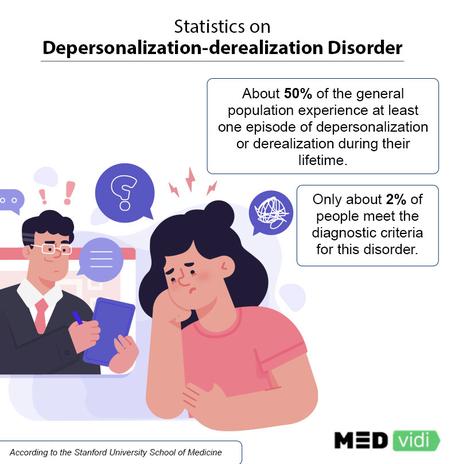- 11 January, 23
 Anxiety
Depersonalization-Derealization Disorder: Symptoms, Causes, and Treatment
Anxiety
Depersonalization-Derealization Disorder: Symptoms, Causes, and Treatment
Brief and rare moments of depersonalization or derealization are common; that’s the feelings of detachment from your body or environment. You might feel like you’re living in a dream or watching your actions in a movie.
According to DSM-V, when these feelings are not transient but experienced repeatedly, they form depersonalization-derealization disorder and affect your functioning. Read on to learn more about this condition, its symptoms, risk factors, and available treatment options.
Anxiety disorders are treatable! Get a diagnosis online and receive a personalized treatment plan at MEDvidi.
Book An AppointmentWhat is Depersonalization-Derealization Disorder (DPDR)?
Depersonalization-derealization disorder or syndrome is a mental health condition characterized by persistent feelings of detachment from self or the surrounding. Typically, you feel that you’re outside your body and the happenings around you are not real. Unlike individuals with psychotic disorders, people with DPDR have insight and understand that their feelings are not true, making them concerned about their mental well-being.
How Common is Depersonalization Disorder?
Up to half of the general population experiences at least an episode of depersonalization or derealization in their lifetime. The feeling is usually temporary, occurring after life-threatening situations, extreme sleep deprivation, ingestion of certain drugs, and periods of over-tiredness.
Sometimes, it occurs as part of another mental disorder or a symptom of physical conditions like convulsion disorder. Drugs such as hallucinogens, ketamine, and marijuana can also precipitate detachment feelings.
However, only about 2% of the individuals who experience feelings of detachment from self or surrounding meet the DSM-V’s diagnostic criteria for the depersonalization-derealization disorder.
Consult an expert to get the right diagnosis and rule out other mental conditions.
See A Doctor OnlineDiagnostic Criteria for the Depersonalization-Derealization Disorder
According to the Diagnostic and Statistical Manual of Mental Disorders, 5th edition, depersonalization qualifies as a disorder when it occurs in the absence of other mental or physical conditions and persists, affecting a person’s functioning. Therefore, before diagnosing depersonalization-derealization disorder, the doctor must rule out conditions such as anxiety, depression, post-traumatic stress disorder, seizure disorders, schizophrenia, and borderline personality disorder that often manifest with transient detachment feelings.
The severity and distressing nature of the symptoms usually make it difficult to maintain relationships and function properly at work, home, or school. The doctor can use specially structured interviews, questionnaires, and psychological tests to examine the symptoms and diagnose the disorder.
Depersonalization-Derealization Disorder Symptoms
The primary feature of depersonalization disorder is feeling disassociated: you might feel like you’re watching your life from the sidelines or living in a dream world. The disorder symptoms usually vary in severity and include:
- Feelings of disconnection from your thoughts, body, and emotions.
- Robot-like status in which you feel unable to control speech or movement.
- Feeling detached from your environment.
- Difficulty recognizing and describing your emotions or experiences (alexithymia).
- Numbness or reduced response to sensations.
- Distortion of objects and distances. Items might appear blurry and smaller or larger than they are in general.
- Increased awareness of the surroundings.
- Feelings of going crazy and anxiety.
These depersonalization and derealization symptoms can be:
- transient, lasting hours to a few days;
- chronic, lasting several weeks to months.
Although the symptoms might be distressing to the extent that the patients become preoccupied with confirming their existence, they usually understand that their feelings are not real. When comparing depersonalization vs psychotic disorders, people with the former have intact reality testing while the latter lack mental insight.
Only a doctor can diagnose depersonalization-derealization disorder. Contact us if you have any disturbing symptoms.
Book An Online Visit
Risk Factors and Causes of Depersonalization-Derealization Disorder
Individuals with a history of traumatic experiences are at a higher risk of having depersonalization episodes or developing the condition. Such traumatic situations may include:
- Suffering neglect or emotional abuse during childhood.
- Witnessing domestic violence.
- Experiencing a sudden loss of a loved one.
- Being a victim of physical or sexual abuse.
- Caring for a severely mentally-ill or physically-impaired parent.
Other triggers of derealization symptoms include severe stress, overstimulation, anxiety, sleep deprivation, depression, and substance abuse, especially hallucinogens.
Depersonalization-Derealization Disorder Treatment
The treatment outcome largely depends on defining and dealing with the underlying causes or triggers. Minor cases of the disorder often recover organically without any formal treatment. However, the moderate-severe forms usually require targeted and personalized therapy to resolve.
- Psychotherapy
Psychotherapy is the most effective method of treating derealization disorders. Many individuals report significant success with psychotherapy, which can take different forms, including cognitive, psychodynamic, and behavioral approaches. Cognitive therapy techniques help to block obsessive thoughts of unreal feelings, while behavioral techniques enhance your engagement in activities that distract you from depersonalization or derealization.
Psychodynamic therapy is the other form of psychotherapy crucial in treating depersonalization disorder. The techniques help individuals to deal with negative feelings and experiences that trigger dissociation from self and the environment.
Grounding is another technique that can help you feel more connected to reality. It uses the five senses to enhance the connection to the self and the environment. For instance, holding an ice cube can help confirm existence when feeling dissociated.
- Medications
Although less efficacious, experts often use antidepressant and anti-anxiety medications to help alleviate the disorder’s symptoms. The most commonly used drugs include selective serotonin reuptake inhibitors, stimulants, benzodiazepines, lamotrigine, and opioid antagonists.
Conclusion
Depersonalization-derealization disorder is a psychiatric condition characterized by the feeling of detachment from reality. Typically, you feel like an outside observer of your life and environment with the awareness that such feelings are not real. Traumatic events, severe stress, and substance abuse are the major precipitators of the disorder. If you experience such feelings often or they prevent you from living a normal life, consider seeking professional help.

Real help for Anxiety.
Beat your symptoms with our expert advice.





- Anxiety attack
- Anxiety disorder
- Anxiety symptoms
- Depersonalization-derealization disorder
- Derealization symptoms
- Sleep anxiety
- Social anxiety disorder symptoms
- Symptoms of anxiety
- What is depersonalization
- What is derealization
